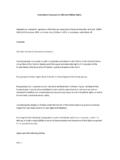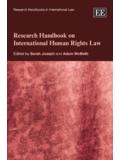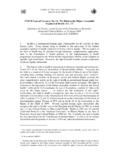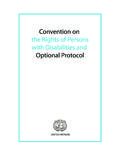Transcription of GLOBAL STRATEGIC FRAMEWORK FOR FOOD SECURITY …
1 1 GLOBAL STRATEGIC FRAMEWORK FOR food SECURITY AND NUTRITION Second draft May 2012 Table of Contents Paragraph I. Introduction and background 1 17 A. The reform of the Committee on World food SECURITY (CFS), Its vision and roles 2 10 B. Nature, purpose, process of elaboration and intended role of the GSF 11 16 C. Definitions 17 II. The root causes of hunger and the challenges ahead 18 21 A. Structural causes of hunger and malnutrition 18 19 B. Emerging challenges and long standing issues 20 C. Past experiences and main lessons learned 21 III. The foundations and overarching frameworks 22 29 A. The Millenium Development Goals 23 B. The Voluntary Guidelines to support the progressive realization of the right to adequate food in the context of national food SECURITY (VGRtF) 24 C.
2 The Five Rome Principles for Sustainable GLOBAL food SECURITY 25 D. High level forums on aid effectiveness 26 27 E. The United Nations Updated Consolidated FRAMEWORK for Action (UCFA) 28 29 IV. Policy, programme and other recommendations 30 66 A. The twin track approach 31 37 B. Increasing smallholder sensitive investment in agriculture 38 42 C. Addressing food price volatility 43 45 D. Addressing gender issues in food SECURITY and nutrition 46 48 E. Increasing agricultural productivity and production in a socially, economically and environmentally sustainable manner 49 53 F. Nutrition 54 56 G. Tenure of land, fisheries and forests 57 63 2 H. Addressing food SECURITY and nutrition in protracted crises 64 66 V. Uniting and organizing to fight hunger 67 99 A.
3 Core actions at country level 69 73 B. Improving regional support to national and local actions 74 79 C. Improving GLOBAL support to regional and national actions, and response to GLOBAL challenges 80 85 D. Making it happen: linking policies and programmes with resources 86 87 E. Monitoring and follow up 88 99 VI. Major existing gaps in consensus on policy issues 100 104 _____ Abbreviations AGRA Alliance for a Green Revolution in Africa AMIS Agricultural Market Information System CAADP Comprehensive African Agriculture Development Programme CEDAW UN Convention on the Elimination of all forms of Discrimination against Women CGIAR Consultative Group on International Agricultural Research CSM Civil Society Mechanism CSO Civil Society Organization FSN food SECURITY and Nutrition GCARD GLOBAL Conference on Agricultural Research for Development GSF GLOBAL STRATEGIC FRAMEWORK HLPE High level Panel of Experts IAASTD International Assessment of Agricultural Knowledge.
4 Science and Technology for Development ICARRD International Conference on Agrarian Reform and Rural Development IFAD International Fund for Agricultural Development ISESCR International Covenant on economic , social and Cultural Rights MDG Millennium Development Goal OHCHR United Nations Committee on economic , social and Cultural Rights SCN UN Standing Committee on Nutrition SOFA State of food and Agriculture SUN Scaling Up Nutrition UCFA United Nations Updated Comprehensive FRAMEWORK for Action UNICEF United Nations Children s Fund UN REACH Renewed Efforts Against Child Hunger and Undernutrition VGGT Voluntary Guidelines on the Responsible Governance of Tenure of Land, Fisheries and Forests in the Context of National food SECURITY VGRtF Voluntary Guidelines to support the progressive realization of the right to food in the context of national food SECURITY WFP World food Programme WHA World Health Assembly WHO World Health Organization 3 GLOBAL STRATEGIC FRAMEWORK FOR food SECURITY AND NUTRITION Second draft food SECURITY exists when all people, at all times, have physical, social and economic access to sufficient, safe and nutritious food that meets their dietary needs and food preferences for an active and healthy life.
5 The four pillars of food SECURITY are availability, access, utilization and stability. The nutritional dimension is integral to the concept of food SECURITY and to the work of I. INTRODUCTION AND BACKGROUND 1. Today hundreds of millions of people suffer from hunger and more than 200 million children under five years of age suffer from malnutrition. The rise in food prices in 2007 08, followed by the financial and economic crisis in 2009, continuing in 2012, have drawn stark attention to the daily challenges faced by millions of families around the world in their attempt to overcome hunger and poverty and seek stable livelihoods that support a just and dignified way of Despite the efforts of many, and the commitment of the international community in the Millennium Declaration to reduce hunger by half by 2015, persistent hunger and malnutrition remains the norm for millions of human beings.
6 A. The reform of the Committee on World food SECURITY , its vision and roles 2. Faced with rising hunger and a fragmented governance for food SECURITY and nutrition, member nations of the Committee on World food SECURITY (CFS) agreed at the 34th Session of CFS in October 2008 to embark on an ambitious reform so that it could fully play its vital role in the area of food SECURITY and nutrition, including international coordination. 3. The CFS Reform, endorsed by all CFS Member Nations in 2009iii, redefines the CFS s vision and roles and aims to expand participation in CFS to ensure that voices of all relevant stakeholders are heard; strengthen its linkages with regional, national and local levels; and support CFS debate and decision makingwith structured expertise through the creation of a High Level Panel of Experts (HLPE) so that the decisions and the work of the CFS are based on hard evidence and state of the art knowledge.
7 4. The 2009 FAO Conference endorsed the CFS reform and instituted the CFS as a Committee hosted in FAO, but including a broad range of stakeholders. FAO, IFAD and WFP compose the CFS s Joint Secretariat. Its membership is open to all member states of the United Nations, who have the responsibility for the CFS s decisions. The whole UN system with a mandate in the field of food SECURITY and nutrition are included as Participants in the Committee s deliberations, with full rights of participation, as are international financial institutions and research institutions and a broad range of non governmental stakeholders, including civil society organizations (CSOs), NGOs, private sector bodies, and philanthropic foundations. 5. The Plenary of the Committee meets regularly once per year, being the central body for decision taking, lesson learning and convergence.
8 A standing Bureau composed of 13 Member Countries, assisted by an Advisory Group composed of the several constituencies of Participants, represent the broader membership of the CFS, preparing plenary sessions and carrying out tasks delegated by the plenary. 4 6. The vision of the reformed CFS is to constitute the foremost inclusive international and intergovernmental platform for a broad range of committed stakeholders to work together in a coordinated manner and in support of country led processes towards the elimination of hunger and ensuring food SECURITY and nutrition for all human beings. The CFS will strive for a world free from hunger where countries implement the voluntary guidelines for the progressive realization of the right to adequate food in the context of national food SECURITY .iv 7.
9 The main roles for the CFS, to be implemented gradually, were defined as providing a platform to promote better coordination at GLOBAL , regional and national levels; promote policy convergence; facilitate support and advice to countries and regions; and promote accountability and share best practices at all levels. v 8. An important outcome of the reform of the CFS has been the increased level of participation and interest by both governmental and non governmental stakeholders. CSOs and NGOs were called to organize themselves autonomously in order to facilitate their interaction and engagement with the Committee, which led to the creation of the Civil Society Mechanism (CSM), and following that a similar mechanism was created by private sector entities. At the same time, several countries and regional organizations and mechanisms are actively debating ways to deepen their engagement in and links to the CFS s initiatives and deliberations.
10 9. Over two regular plenary sessions in 2010 and 2011, the reformed CFS achieved considerable success in providing concrete policy guidance and promoting consensus among its Members and Participants on a number of relevant issues for food SECURITY and nutrition, including food price volatility, gender, investments in smallholder agriculture, protracted crises, statistics on hunger, and others. Other ongoing initiatives, such as the mapping of food SECURITY and nutrition actions, are aimed at promoting better coordination and monitoring at all levels. In May 2012 the CFS endorsed the Voluntary Guidelines on the Responsible Governance of Tenure of Land, Fisheries and Forests (VGGT)vi, contributing to fill an important gap in international policy advice. 10. Despite those successes, however, there is still a need to improve communication and dissemination of the CFS s conclusions and recommendations, reinforce links with the national and regional levels, and improve the policy convergence and coordination roles of the CFS by consolidating its outcomes in a dynamic and highly visible instrument.
















